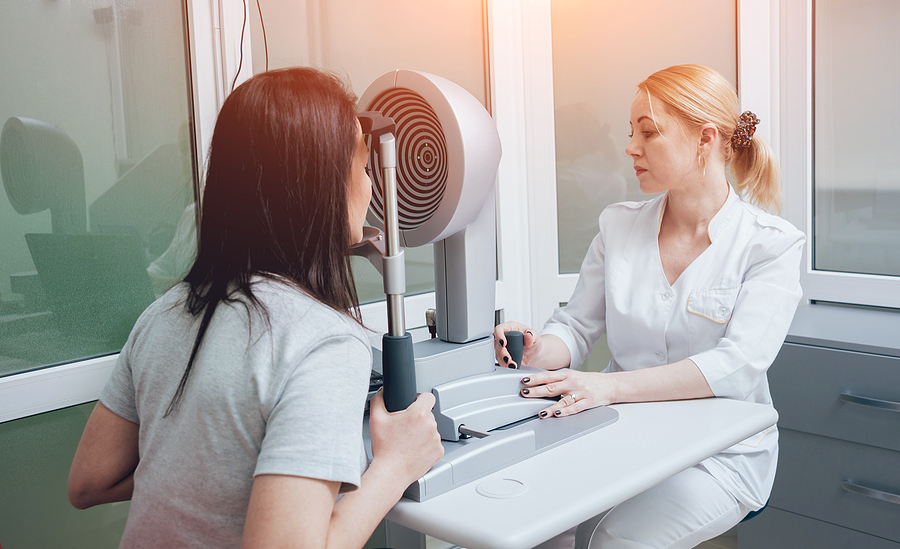Corneal Abrasion and Corneal Erosion
Corneal Abrasion
The cornea is the clear front window of the eye. It covers the iris (the colored portion of the eye) and the round pupil. The cornea is composed of five layers. The outermost layer is called the epithelium.
Injuries to the epithelium, such as scratches, cuts, or scrapes, are known as corneal abrasions. Usually, these injuries are caused by fingernail scratches, makeup brushes, paper cuts, or rubbing of the eyes. Sometimes conditions like dry eye can cause abrasions. Symptoms associated with corneal abrasions include tearing, redness, pain, soreness, and blurred vision.
Treatment options for corneal abrasions include patching the injured eye, dilating pupils to relieve pain, wearing special contact lenses that promote healing, taking antibiotics to prevent infection, and using lubricating eyedrops.
Minor abrasions usually heal within a day or two, while larger abrasions take about a week.

Corneal Erosion
Corneal erosion is caused by a loose attachment of the epithelium to the underlying tissue. This often happens at the site of an earlier abrasion. Some patients have an underlying condition called “map-dot-fingerprint dystrophy” that predisposes them to having recurrent corneal erosions.
Symptoms of corneal erosion are similar to those of abrasions: pain, soreness, redness, and blurred vision.
Treatment is the same as for corneal abrasion and may also include saline solution eyedrops or ointments. However, if the erosion keeps occurring, further treatment may be necessary. These treatments may include procedures to remove the damaged epithelium, removal of corneal cells using a laser, or performing an anterior stromal puncture, which involves making tiny holes on the surface of the cornea to promote stronger attachments between the top layer of corneal cells and the layer of the cornea underneath.
Corneal Ulcers
Corneal ulcers, or keratitis, can form due to trauma to the cornea, eyelid disease, severe dry eye, fungus, herpes simplex viral infections, and other causes.
There are two very common types of corneal ulcers. Bacterial ulcers tend to be the most painful type of corneal ulcer, and in some cases, if left untreated, can cause severe damage or even corneal perforation. Sterile ulcers, on the other hand, usually cause little or no pain.
Improper care and handling of contact lenses, which can lead to infection, are often causes of corneal ulcers.
The symptoms of corneal ulcers may include:
* pain;
* redness;
* blurred vision;
* tearing;
* discharge; and
* sensitivity to light.
Treatment for corneal ulcers depends on the cause. It usually includes steroid eyedrops, anti-inflammatory drops, or antibiotics. In some cases, hospitalization may be necessary in order to administer eyedrops every hour around the clock, intravenous antibiotics, and other treatments. In rare cases when the cornea is severely damaged, a corneal transplant may be necessary to improve vision.
Fuchs’ Dystrophy
Fuchs’ dystrophy is a progressive disease that affects the cornea, the clear dome that covers the iris (the colored part of the eye) and helps focus light as it enters the eye.
With this disease, cells in the cornea’s inner layer, called the endothelium, are reduced in number. This causes the remaining cells to swell or thicken. The loss of endothelial cells can also allow abnormal dewdrop-shaped growths called guttata to form.
These cell changes may cause the cornea to become cloudy and swollen. Because Fuchs’ dystrophy is a progressive disease, the changes to the cornea can interfere with vision over time. Fuchs’ dystrophy usually occurs in people after age 40. Studies show that it is an inherited condition.
Symptoms of Fuchs’ dystrophy include hazy or cloudy vision that develops in stages. In the first stage, as the cornea swells, vision in the morning may be hazy, but it clears up during the day. Once the disease has progressed to a more advanced stage, vision no longer clears, and instead, you may experience pain and sensitivity to light.
It can take up to 20 years or longer for Fuchs’ dystrophy to progress from its earliest stage to a stage that is visually or physically significant. To diagnose and monitor this condition, an ophthalmologist at The Center for Eye Health checks for adequate endothelial cell number and function, obtains an endothelial cell count, and may measure the thickness of the cornea.
In its early stage, Fuchs’ dystrophy is treated with saline eyedrops to pull excess fluid from the cornea or by using a hairdryer to help dry the surface of the cornea. As Fuchs’ dystrophy advances, you may be given a therapeutic bandage contact lens to lessen your discomfort.
If vision loss begins to interfere with your life in the latter stages of the disease, a corneal transplant technique known as penetrating keratoplasty may be performed. This procedure has an excellent success rate.
Fungal Keratitis
Fungal keratitis is a serious infection of the cornea—the clear, round dome covering the eye’s iris and pupil. Symptoms of fungal keratitis include:
* sudden blurry vision;
* unusual redness of the eye;
* pain in the eye;
* excessive tearing or discharge from your eye; and
* increased light sensitivity.
Risk factors for fungal keratitis include trauma (usually when plant material gets into the eye), chronic or ongoing disease of the surface of the eye, a compromised immune system, and, rarely, contact lens use. Keratitis is not transmitted from person to person.
Fungal keratitis is treated with topical and oral antifungal medications. Patients who do not respond to medical treatment may require eye surgery, possibly including a corneal transplant.

Safe handling, storage, and cleaning of contact lenses are key measures for reducing the risk of infection. You should always use the following safe practices with your lenses:
* Wash your hands with soap and water and dry them before handling lenses.
* Wear and replace your lenses according to the schedule prescribed by your ophthalmologist at The Center for Eye Health.
* Follow instructions from your ophthalmologist and your lens solution manufacturer for cleaning and storing your lenses.
* Make sure you always use fresh lens solution and replenish the solution daily.
* Keep your contact lens case clean and replace it every three to six months.
* Remove your lenses and consult an ophthalmologist immediately if your eyes become red or irritated or if your vision changes.
No matter which cleaning or disinfecting solution you use, consider performing a “rub and rinse” lens cleaning method rather than a “no-rub” method. This can minimize the number of germs on your lenses, reducing your chances of infection.
Herpes Keratitis
Herpes keratitis is a viral infection of the eye caused by the herpes simplex virus, best known for causing cold sores. Herpes keratitis usually affects only one eye and most often occurs on the cornea—the normally clear dome that covers the front part of the eye.
The symptoms of herpes keratitis may include:
* pain;
* redness;
* blurred vision;
* tearing;
* discharge; and
* sensitivity to light.
If the infection is superficial, with ulcers involving only the cornea’s top layer, called the epithelium, it will usually heal without scarring. However, if it involves the deeper layers of the cornea, it may lead to scarring of the cornea, loss of vision, and sometimes even blindness. Left untreated, herpes keratitis can severely damage your eye.
Herpes keratitis is usually treated with antiviral medications, either in eyedrop or pill form. Depending on the progression of the infection, your ophthalmologist at The Center for Eye Health may treat your condition with steroid eyedrops to reduce inflammation. Rarely, when the cornea is severely damaged, a corneal transplant may be necessary to improve vision.
Keratoconus
Keratoconus is an uncommon condition in which the dome-shaped cornea (the clear front window of the eye) becomes thin and develops a cone-like bulge. As the condition progresses, the shape of the cornea is altered, distorting your vision. Usually, keratoconus affects both eyes, although symptoms and progression in each eye may differ.
Early symptoms include mild blurring of vision, increased sensitivity to light and glare, and mild eye irritation. The rate of progression varies. Keratoconus usually begins in the teenage years. It may progress slowly for 10 to 20 years and then suddenly stop. As it progresses, the most common symptoms are increased blurring, increased nearsightedness or astigmatism, inability to wear contact lenses, and frequent eyeglass prescription changes.
The causes of keratoconus are not known. Since an estimated 10% of people with keratoconus have a family member with the condition, some researchers believe genetics may play a role.
Keratoconus is usually corrected with eyeglasses. However, as the condition progresses, rigid contact lenses may be needed so that vision is improved. If vision is greatly affected, a corneal transplant may be recommended. While this procedure will relieve the symptoms of keratoconus, it will not cure it completely. Nonetheless, corneal transplants offer the best prognosis for clear vision.
A new technique recently has been evaluated to treat progressive keratoconus. This technique involves placing crescent-shaped acrylic inserts in the midperiphery of the cornea. This has been shown to be effective in some patients. You should discuss this technology with your ophthalmologist at The Center for Eye Health.
Pterygium and Pinguecula
A pterygium is a mass of fleshy tissue that grows over the cornea (the clear front window of the eye). It may remain small or may grow large enough to interfere with vision. A pterygium most commonly occurs on the inner corner of the eye, but it can appear on the outer corner as well.
The exact cause of pterygia is not well understood. They occur more often in people who spend a lot of time outdoors, especially in sunny climates. Long-term exposure to sunlight, especially to ultraviolet (UV) rays, and chronic eye irritation from dry, dusty conditions seem to play an important role. Dry eye also may contribute to pterygium.
When a pterygium becomes red and irritated, eyedrops or ointments can be used to help reduce the inflammation. If the pterygium grows rapidly or is large enough to threaten sight, it can be removed surgically.
Despite proper surgical removal, a pterygium may return, particularly in young people. Protecting the eyes from excessive ultraviolet light with proper sunglasses, avoiding dry, dusty conditions, and using artificial tears can also help.
A pinguecula is a yellowish patch or bump on the white of the eye, most often on the side closest to the nose. It is not a tumor but is an alteration of normal tissue resulting in a deposit of protein and fat. Unlike a pterygium, a pinguecula does not actually grow onto the cornea. A pinguecula can also be a response to chronic eye irritation or sunlight.
No treatment is necessary unless the pinguecula becomes inflamed. A pinguecula does not grow onto the cornea or threaten sight. On rare occasions, a pinguecula can be surgically removed if it is particularly annoying.

